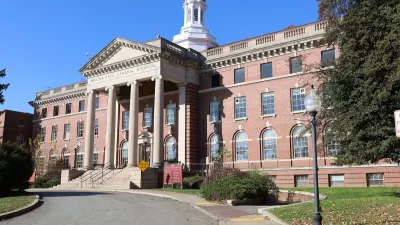As if to show that "walkable" is the new mobility in America, even with single-family-homes, new census findings show two-thirds of homes constructed last year had front porches while the number of garages or carports decreased to late 1990 levels.
Haya El Nasser and Paul Overberg report on the 2011 U.S Census survey and find results showing a ten-year trend.
- New homes with front or rear porches has grown from 42% in 1992 to 65% in 2011
- 13% of homes were built without a garage or carport in 2010 and 2011 compared with 8% in 2004
To be sure, no one is suggesting that walking, biking, and public transit will replace the private automobile in neighborhoods composed mostly of single family homes, even new ones. However, even Stephen Melman of the National Association of Home Builders did state about the findings: "It's very positive about public transportation if new construction is starting to be built closer to employment centers or transit."
The porches may say more about homebuyers desire to interact (to a certain level) with their neighbors than mobility.
"The front porch acts as a social mechanism," says Christopher Leinberger, president of Smart Growth America's LOCUS, a coalition of developers and investors who promote walking over driving. "You sit on the porch and talk to people walking by without having to invite them in. It's outdoor space without taking up too much space."
Also reporting on the findings, Streetsblog Capitol Hill's Tanya Snyder writes, "(D)evelopers are (belatedly) building what the market wants: denser housing in walkable urban centers near transit. Copious parking and driveway curb cuts simply don't mesh with that model."
Thanks to Streetsblog San Francisco
FULL STORY: Front porches making a big comeback

Study: Maui’s Plan to Convert Vacation Rentals to Long-Term Housing Could Cause Nearly $1 Billion Economic Loss
The plan would reduce visitor accommodation by 25,% resulting in 1,900 jobs lost.

North Texas Transit Leaders Tout Benefits of TOD for Growing Region
At a summit focused on transit-oriented development, policymakers discussed how North Texas’ expanded light rail system can serve as a tool for economic growth.

Why Should We Subsidize Public Transportation?
Many public transit agencies face financial stress due to rising costs, declining fare revenue, and declining subsidies. Transit advocates must provide a strong business case for increasing public transit funding.

How to Make US Trains Faster
Changes to boarding platforms and a switch to electric trains could improve U.S. passenger rail service without the added cost of high-speed rail.

Columbia’s Revitalized ‘Loop’ Is a Hub for Local Entrepreneurs
A focus on small businesses is helping a commercial corridor in Columbia, Missouri thrive.

Invasive Insect Threatens Minnesota’s Ash Forests
The Emerald Ash Borer is a rapidly spreading invasive pest threatening Minnesota’s ash trees, and homeowners are encouraged to plant diverse replacement species, avoid moving ash firewood, and monitor for signs of infestation.
Urban Design for Planners 1: Software Tools
This six-course series explores essential urban design concepts using open source software and equips planners with the tools they need to participate fully in the urban design process.
Planning for Universal Design
Learn the tools for implementing Universal Design in planning regulations.
City of Santa Clarita
Ascent Environmental
Institute for Housing and Urban Development Studies (IHS)
City of Grandview
Harvard GSD Executive Education
Toledo-Lucas County Plan Commissions
Salt Lake City
NYU Wagner Graduate School of Public Service





























